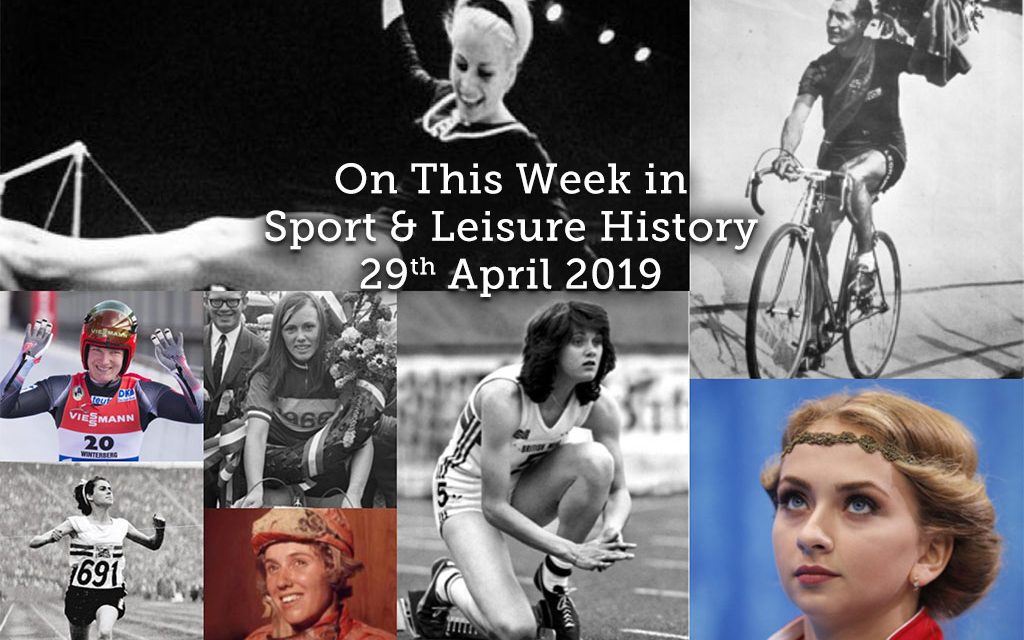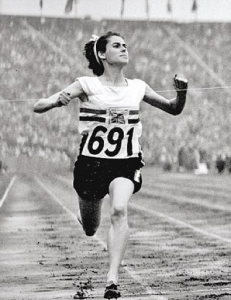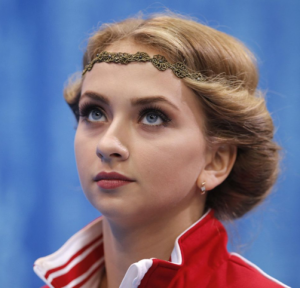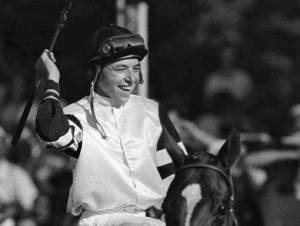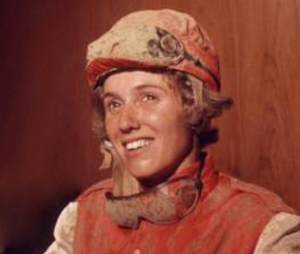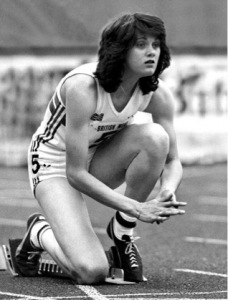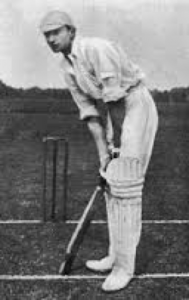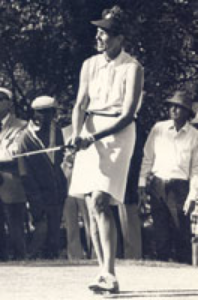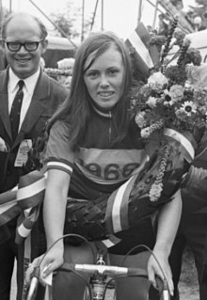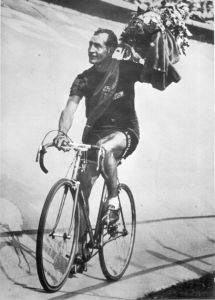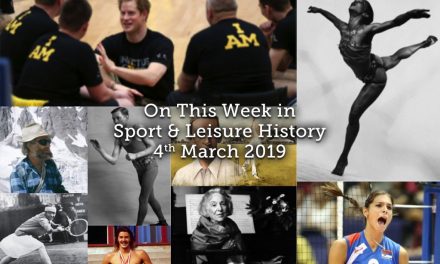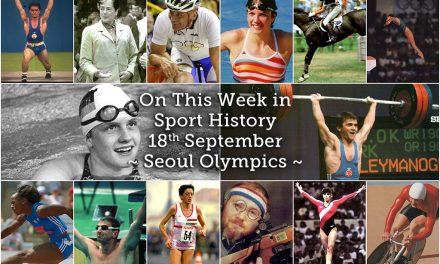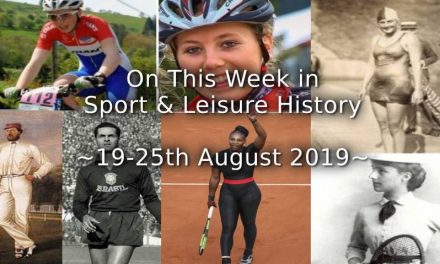29th
- On this day in 1879 Sir Thomas Beecham, founder of the London Philharmonic was born.
- The American swimmer Raymond Thorne was born today in 1887.
- In the 1904 Olympics he won a silver medal as a member of American 4x50yard freestyle relay team and was sixth in the 50yards. He died at the age of 33 in 1921 in a car crash in Los Angeles.
- Today in 1922 the first official International Weightlifting Championships took place in Tallinn, Estonia.
- Al Balding the Canadian professional golfer, who in 1955 he became the first Canadian to win a PGA Tour event in the USA was born in 1924; Canadians Ken Black (1936 Vancouver Jubilee Open) and Jules Huot (1937 General Brock Open) had won PGA Tour events in Canada in the 1930s.
- The British sprinter, Dorothy Manley, later Hall, then Parlett; was born in 1927. She raced for the Essex Ladies athletics club and was added to a national list of potential Olympians in late 1947, assigned to train with Sandy Duncan. She began her training for the 1948 Games early in March 1948, training on the track four times a week, but never using the gym. Manley described the trials as a “fiasco”, having finished fifth at the Women’s Amateur Athletic Association Championships, but was still picked to represent the United Kingdom. She was working full-time during 1948 for the Suez Canal Company as a typist, and used her summer holidays to attend the games although the leave was unpaid by her employer. Her mother made her running vest and shorts for the Games, but she was given the blazer and skirt for the opening ceremony. While at the Games, she travelled to and from Wembley on the London Underground, as she was sharing a room with two other athletes near Eccleston Square in central London. She qualified for the 100m final, and finished second, winning silver in her first international athletics event. Fanny Blankers-Koen won the gold medal in first place with a time of 11.9s, while Manley’s time was 12.2s, just ahead of Shirley Strickland de la Hunty, who registered the same time. Manley described her start in the race as the “best of her life”, having described her normal starts as notoriously bad. She thought that this may have actually distracted her as her start was so good that she was expecting the race to be recalled. She won the WAAA Championships 200m title at the 1950 meeting at White City Stadium, which was her only WAAA title She retired from athletics in 1952 after suffering from a thyroid condition At the 1950 British Empire Games in New Zealand, she was asked after arrival if she would like to compete in the high jump – only then finding out that she had been entered in the event without her knowledge. With minimal training in the time available, she competed in the event and finished fourth behind Dorothy Tyler, Bertha Crowther and Noeline Swinton. She was part of the women’s relay teams at the Games, and won silver in the 660yards relay and bronze in the 440yards relay. The team won gold in the 4×100m relay at the 1950 European Athletics Championships. She described that race as particularly exciting as they had beaten the Dutch team, which included Fanny Blankers-Koen.
- One of Britain’s best known squash players, Jonah Barrington, was born in 1941. He won the British Open championship six times between 1967 and 1974. The World Open title was inaugurated too late in Barrington’s career for him to add it to his impressive list of tournament successes.
- Soviet cross country skier Galina Kulakova was born in 1942, he was arguably the best skier over distances under 10k in the early 1970s. She won four Olympic golds, two individual in 1972 and two relay golds in 1972 and 1976. She was the most successful athlete at the 1972 Winter Olympics, along with Ard Schenk of the Netherlands. Competing in the World Championships, she won three individual golds, two in 1974 and one in 1970, and also two relay golds in those years. Kulakova also won the 10k event at the Holmenkollen ski festival in 1970 and 1979. Galina Kulakova was also 39 times Champion of the USSR between 1969 and 1981. For her achievements she was awarded Order of Lenin and Badge of Honour. She was also awarded the silver Olympic Order in 1984 by the International Olympic Committee President Juan Antonio Samaranch. Galina Kulakova retired in 1982.
- American golfer Johnny Miller was born in 1947. He won the US Open in 1973 and the British Open at Birkdale in 1976.
- Sofia Sakorafa, Palestinian-Greek politician and former javelin thrower was born today in 1957. She is currently an Independent Member of the European Parliament for Greece, having formerly sat for Syriza and before that served, from June 2012 to July 2014, as a Syriza Member of the Hellenic Parliament. She started competing in athletics at 15 as a member of Trikala Gymnastic Club. In total, Sakorafa – often pushed by her antagonism with Anna Verouli – broke the Greek record for the javelin 17 times. She competed in the 1976 and 1980 Olympics. Sakorafa broke the world record on 16 September 1982 with a throw of 74.20m which stood as a Greek record until the new style javelin was introduced in 1999. She won bronze at the 1982 European Athletics Championships but caused controversy in 2004 when she became a Palestinian citizen and applied a few months before the Olympic Games for a place on the Palestinian Olympic team at the age of 47. She made her debut representing Palestine in Chania, Crete, on 28 June 2004 – with a throw of 47.23m. Despite the fact that her gesture to participate as a Palestinian was symbolic, the IAAF ruled her ineligible for the 2004 Olympics.
- Rob Druppers, Dutch middle-distance runner was born on this day in 1862. He won the 800m silver at the 1983 World Championships and set a Dutch 800m record of 1:43.56 in Cologne in 1985, and a 1000m record of 2:15.23 in his home town Utrecht in the same year. Druppers competed in the 1988 Olympics, where he reached the quarterfinals of the 800m.
- Muhammed Ali was stripped of his world heavyweight title in 1967 for refusing, on religious grounds, to be drafted into the US Army.
- On this day in 1968 the controversial musical Hair, a product of the hippie counter-culture and sexual revolution of the 1960s, opened at the Biltmore Theatre on Broadway, with some of its songs becoming anthems of the anti-Vietnam War movement.
- Chelsea beat Leeds United 2-1 after extra time at Old Trafford to win the replay of the 1970 FA Cup Final, the first replay of a Wembley final.
- The final of the 1989 Pilkington Cup at Twickenham attracted a world record attendance for a rugby union cup match of 59,300. Bath ran out 10-6 winners over Leicester.
- In 1990 Stephen Hendry beat Jimmy White 18-12 to become the youngest world snooker champion at the age of 21 years and 106 days.
- The Law Society Legal Handicap Hurdle at Hexham in 1991 saw a record-equalling seven horses start the race as co-favourites. Six of them filled the first six places.
- Victoria Sinitsina, Russian ice dancer, was born today in 1995. With her skating partner Nikita Katsalapov, she is the 2016 Russian national silver medallist. With former partner Ruslan Zhiganshin, she is the 2012 World Junior champion and won bronze at the 2013 Winter Universiade, 2012 Rostelecom Cup, and 2014 Russian Championships.
- In 2013 an NBA league committee recommended that NBA owners reject a bid from a group led by Chris Hansen and Steve Ballmer to purchase the Sacramento Kings and move them to Seattle.
- In 2015 a baseball game between the Baltimore Orioles and the Chicago White Sox sets the all-time low attendance mark for Major League Baseball. Zero fans were in attendance for the game, as the stadium was officially closed to the public due to the 2015 Baltimore protests.
- Dorothy Manley
- Victoria Sinitsina
30th
- Léon Flameng, French cyclist and a World War I pilot, was born on this day in 1877. Flameng competed in four cycling track events at the 1896 Olympics, on the 8th April, he competed in the 100k race which was 300 laps of the Neo Phaliron Velodrome, out of the nine starters, two finished with Flameng winning gold 11 laps ahead of second place Georgios Kolettis from Greece. After a couple of days rest he was back in the saddle at the Velodrome competing in three more events, he won silver in the 10k race finishing just behind fellow countryman Paul Masson, he also won bronze in the sprint race, which was six laps around the Velodrome and finally he finished in joint fifth place in the time trial. In 1898 he joined the 8th Infantry Division to do his National Service, he then joined the French Air Force in 1914 as an observer before becoming a military pilot in 1916 on the 21st June 1916, while on a mission on Verdun his plane was hit and although he was hit in the head with a bullet and his crew killed he still managed to get his plane back to base, after being hospitalised he returned to his squadron and was promoted to sergeant before transferring to the Group of Training Division. Sadly, on the 12th January 1917, while trialing a new Sopwith biplane near Ève, Oise, there was a technical incident forcing the plane to crash to the ground killing Flameng.
- Levi Celerio the Filipino composer and lyricist was born in 1910. Celerio was a prolific songwriter, with over 4,000 songs to his credit. He is perhaps best known for being a leaf-player, a feat for which he was put into the Guinness Book of World Records. In 1997, he was named National Artist of the Philippines for Music.
- Anton Murray, South African cricketer was born in Grahamstown, Cape Province in 1922. He played in 10 Tests in a little over a year from December 1952 to February 1954, appearing four times against Australia and then six times against New Zealand. He later toured England as a member of the 1955 South African side but did not appear in any of the Tests. Outside cricket, he was a schoolmaster by profession and in 1963; he was the founding headmaster of St Alban’s College, a progressive boarding school in Pretoria, where he remained as head there until retirement in 1984.
- The West Germany tennis player Karl Meiler was born in 1949. He won four singles (1972, Buenos Aires; 1974, Omaha and Calgary; 1977 Manila) and seventeen doubles titles during his professional career. He notably beat top seed Ken Rosewall in the 1973 Australian Open, where he went on to reach the semi-final. The German reached his highest singles ATP-ranking in 1973, when he became World No. 20. He died aged 64 on 17 April 2014, of complications from a head injury sustained in November 2013.
- Olympian Daniela Costian was born in Romania in 1965 but became an Australian citizen in 1990. She won discus bronze at the 1992 Olympics and silver at the1993 World Championships. Her personal best was 73.84m, set in 1988, which was a Romanian record. Her best result achieved for Australia was 68.72m set in 1994, which is the current Oceanian record.
- Tatjana Hüfner, German luger was born on this day in 1983. She won bronze in the women’s singles at the2006 Winter Olympics in Turin and gold at the 2010 Winter Olympics in Vancouver. Hüfner won eight gold medals at the FIL World Luge Championships, winning five in the women’s singles event (2007, 2008, 2011, 2012, 2017) and three in the mixed team event (2008, 2012, 2017). She also won two silvers in the women’s singles event at the FIL European Luge Championships (2004, 2006). Hüfner won the overall Luge World Cup title in women’s singles three times (2007–08, 2008–09, 2009–10). On February 2, 2008, she became the first woman to win five straight FIL Luge World Cup events with her victory at the bobsleigh, luge, and skeleton track in Altenberg, Germany.
- Sander Baart, who is a Dutch field hockey player of Belgian descent, was born today in 1988. He started playing at the age of 6 at R. Antwerp H.C. in Belgium and in his final season with them in 2007 won the Belgian national title. As of the 2007-2008 season he was playing for the Dutch club Oranje-Zwart. In 2014 he also won the Dutch national title with his club. Followed by the double in 2015, with Oranje-Zwart, winning the national title as well as the EHL (Euro Hockey League). As a junior player he played for the Belgian national team Boys Under 16 and won the European title with them. Later on he switched to the Dutch national teams and won European silver and gold medals for the Dutch Under 21 team and the silver medal at the Junior World Championship (U21). He played his first official match for the Dutch national men’s team in 2007 against Korea. At the 2012 Olympics, he competed for the national team in the men’s tournament. With the national team he won a gold medal in the first World League in 2014 and in 2015 the European Championship. He represented the Uttar Pradesh Wizards in the first three seasons of the Hockey India League.
- On this day in 1993 the world number one women’s tennis player, Monica Seles, was stabbed in the back during a quarter-final match in Hamburg. The 19-year-old American star was rushed to hospital with a wound half an inch (1.5cm) deep in her upper back. Doctors said her injuries were serious, but not life-threatening. “She was very lucky,” said the tournament doctor, Peter Wind. “Neither the lungs nor the shoulder blades were affected. Monica is still suffering from shock, and will stay overnight for observation.” There was immediate speculation that the attack was politically motivated because of Monica Seles’s Serbian roots. She was known to have received death threats in connection with the Yugoslav conflict. The attack happened during the rest break in the match, against Bulgarian player Maggie Maleeva. Miss Seles was leading 6-4, 4-3 when she took a rest on her courtside seat during the changeover. A man described as stocky and balding leaned over the three-feet-high (91 cm) barrier and stabbed her from behind. Miss Seles let out a scream, clutched her back and stumbled on to the court. The attack took place in full view of the 6,000-strong crowd watching the match. The umpire, Stefan Voss, ran from his chair for ice and a towel. It was over two years before Seles returned to tennis competition. Her first tournament was the 1995 Canadian Open, which she won.
- On this day in 1994 Formula One racing driver Roland Ratzenberger was killed in a crash during the qualifying session of the San Marino Grand Prix at Autodromo Enzo e Dino Ferrari outside Imola, Italy. He went off-track on the previous lap, damaging his front wing, but rather than come into the pits, he continued, since he was competing for the final grid spot.The high speed on the straight, and therefore the high downforce generated, finally broke the wing off, sending it under the car. His car failed to turn into the Villeneuve Corner and struck the outside wall at 314.9km/h (195.7mph). Ratzenberger was pronounced dead on arrival at Maggiore Hospital in Bologna, having been airlifted there from the Imola circuit’s medical centre, where he had initially been transferred to from the crash site by ambulance. Ratzenberger was the first racing driver to lose his life at a grand prix weekend since the 1982 season, when Riccardo Paletti was killed at the Canadian Grand Prix at the Circuit Gilles Villeneuve. Ratzenberger was also the first driver to die in an F1 car since Elio de Angelis during testing in 1986. The very next day, seven laps into the Grand Prix race, three-time World Champion Ayrton Senna was killed in another accident. Both deaths brought the sport of Formula One under international scrutiny. The double tragedy was marked before the start of the next race in Monaco, with the front row of the grid left empty and the two slots painted with a Brazilian and Austrian flag.
- The Norweigan swimmer Alexander Dale Oen died on this day in 2012 aged just 26. He represented the clubs Vestkantsvømmerne (1995–2010) and Bærumsvømmerne (2011–2012). Dale Oen’s gold at the 2008 European Championships made him the first Norwegian male to win a medal at a major international long course championship. Dale Oen got his international breakthrough in 2005, placing seventh in the 100m breaststroke at the 2005 World Aquatics Championships. During the European short-course Championships in December the same year, he swam the 100m breaststroke in 59.05s, setting a new Nordic Record. He became the first Norwegian to swim this distance in less than 1 minute. At the Norwegian Short Course Championships two months later, he bettered that time to 58.81, a world best mark for the year. On 30 April 2012, Dale Oen was found unconscious in his hotel bathroom after having suffered a heart attack, caused by chronic, undetected coronary heart disease, a rare disease for a person of his age and fitness. He was found in his bathroom by one of his teammates, and CPR was performed before he was taken to the Flagstaff Medical Centre where he was pronounced dead. Dale Oen was attending a training camp with the Norwegian swimming team in Flagstaff at the time.
- Shirley Firth, Canadian cross-country skier, died on this day in 2013, at the age of 59. She competed in the Winter Olympics in 1972, 1976, 1980 and 1984. A member of the Gwich’in First Nation, Firth was one of the first indigenous North Americans to represent Canada in the Olympic Games. Firth was the recipient of the Order of Canada, the Queen Elizabeth II Golden Jubilee Medal, and the Queen Elizabeth II Diamond Jubilee Medal. She was the twin sister of fellow ski team member Sharon Firth. They became the first indigenous women to be inducted into Canada’s Sports Hall of Fame in 2015. Shirley had previously received a National Aboriginal Achievement Award in the sports category in 2006.
- Léon Flameng
- Tatjana Hüfner
1st
- On this day in 1486 Christopher Columbus convinced Queen Isabella to fund his expedition to the West Indies.
- Today in 1786 in Vienna, Austria, Mozart’s opera The Marriage of Figaro was performed for the first time.
- Queen Victoria opened The Great Exhibition at the Crystal Palace on this day in 1851.
- The first international football match outside Great Britain was played by Belgium and France at Uccle, near Brussels, in 1904, the teams drew 3-3.
- Born on this day in 1914 Dutch javelin thrower Jaap van der Poll, he competed at the 1936 Olympics. He threw in the first round, but had to withdraw due to kidney stones. He commented on his Olympic appearance saying “I felt flattered that I was allowed into the Olympic Games. I was in my eyes only just started with that sport. My friends also said: Go! I made a sporting choice. When I returned I was again welcome to my Jewish friends. That was a comfort to me”. After the games Van der Poll left to work in the Dutch West Indies and was later held as a Prisoner of War in Japan. He died on February 1, 2010.
- Henri Pélissier, French racing cyclist from Paris and champion of the 1923 Tour de France, died on this day in 1935, aged 46. In addition to his 29 career victories, he was known for his long-standing feud with Tour founder Henri Desgrange and for protesting against the conditions endured by riders in the early years of the Tour. He was killed by his lover with the gun that his wife had used to commit suicide two years previously.
- On this day the 1940 Olympics were officially cancelled. Stirling Moss and co-driver Dennis Jenkinson became the first British winners of the Mille Miglia in 1955.
- In 1958 Barcelona won the first Inter-Cities Fairs Cup final, beating London 6-0 in the second leg. American jockey Steve Cauthen was born in 1960. After a successful career in the US, including partnering Triple Crown winner Affirmed in 1978, Cauthen came to England. He won his first of three jockey’s championships in 1984 and in the following year had his first success in the Epsom Derby, with Slip Anchor. Reference Point gave Cauthen his second victory in the race, in 1987.
- On this day in 1961 betting shops became legal in Britain.
- Billie Jean King acknowledged a lesbian relationship with Marilyn Barnett today in 1981, thereby becoming the first prominent sportswoman to ‘come out’.
- Ben Lexcen, designer of Australia II, the first non-American yacht to win the America’s Cup (1983), died in 1988.
- Today in 1994, the Brazilian racing driver Ayrton Senna was killed in a crash at the San Marino Grand Prix at Imola, near Bologna in Italy. He was just 34-years-old. His Williams FW16 Formula One car was travelling at a speed of 192 mph (309 km/h) when it ran wide at a curve and crashed into a concrete wall. Winner of 41 Grands Prix, Senna was considered the finest motor racing driver of his generation and was mourned by fans the world over. “This is the blackest day for Grand Prix racing that I can remember in the many, many years I have been covering the sport,” said veteran BBC sports commentator Murray Walker. Senna was well-known for his aggressive driving style. In 1989 he collided with French driver Alain Prost in the Japanese Grand Prix. He was disqualified and lost his title. The following year, the same thing happened and this time, Senna went on to win as Prost dropped out. Afterwards he told reporters: “Winning is like a drug. I cannot justify in any circumstances coming second or third.”
- Elizabeth Ann Hulette better known in professional wrestling circles as Miss Elizabeth or simply Elizabeth, was an American professional wrestling manager and occasional professional wrestler, died on this day in 2003 at the age of 42. She gained international fame from the mid-1980s to the early 1990s in the World Wrestling Federation, and the mid-1990s in World Championship Wrestling in her role as the manager to wrestler “Macho Man” Randy Savage, as well as other wrestlers of that period. She died as a result of a drug and alcohol overdose in the home she shared with wrestler Lex Luger.
- British multiple motorcycle Grand Prix road racing world champion Geoffrey Ernest Duke died on this day in 2015. Duke was the most famous rider to adopt one-piece leathers, after enlisting his local tailor, Frank Barker, to make the first of his now famous one-piece race suits. Duke had previously used a one-piece lining under his two-piece leather racing suit, to facilitate easy movement, for which he received “ribald remarks from my team-mates!” He was named Sportsman of the Year in 1951, awarded the RACSegrave Trophy and, in recognition of his services to motorcycling, was awarded the Order of the British Empire in 1953.
- Steve Cauthen
- Miss Elizabeth
2nd
- On this day in 1536 Anne Boleyn, Queen of England, was arrested and imprisoned on charges of adultery, incest, treason and witchcraft.
- Born on this day in 1859 Jerome K Jerome, English writer and humourist, best-known for the comic travelogue Three Men in a Boat (1887).
- English/American ballroom dancer Vernon Castle was born today in 1887 in Norwich, England. Together with his wife Irene they were a husband-and-wife team who appeared on Broadway and in silent films early in the early 20th century. They are credited with reviving the popularity of modern dancing. The couple reached the peak of their popularity in Irving Berlin’s first Broadway show, Watch Your Step (1914), in which they refined and popularized the Foxtrot. They also helped to promote ragtime, jazz rhythms and African-American music for dance. Irene became a fashion icon through her appearances on stage and in early movies, and both Castles were in demand as teachers and writers on dance. After serving with distinction as a pilot in the British Royal Flying Corps during World War I, Vernon died in a plane crash on a flight training base in Texas in 1918. Irene continued to perform solo in Broadway, vaudeville and motion picture productions over the next decade. She remarried three times and became an animal-rights activist. In 1939, her life with Vernon was dramatized in The Story of Vernon and Irene Castle.
- Dr Benjamin Spock was born on this day in 1903. Some 20 years before writing the best-selling Common Sense Book of Baby and Child Care (1946) Spock was a member of the US rowing eights gold medal team at the 1924 Paris Olympics.
- Albert Castelyns, also known as Albert Casteleyns, Belgian athlete was born today in 1917. At the 1936 Olympics in Berlin he was part of the Belgian water polo team that won the bronze medal, he played five matches. In the 1950s Casteleyns competed in bobsleigh. Taking part in two Winter Olympics (1952 and 1956), he earned his best finish, sixth in the two-man event at Oslo in 1952.
- On this day in 1952 the world’s first ever jet airliner begun its maiden flight from London to Johannesburg. Crowds cheered as the BOAC Comet G-ALYP took off from London airport at 1512 local time carrying 36 passengers. The De Havilland Comet 1 was regarded as a feather in the cap for British design and innovation and promised to usher in a new era of faster, smoother air travel. The plane’s sleek design incorporated four De Havilland Ghost 50 Mk1 engines inside the wing of the plane. The total journey of nearly 7,000 miles was expected to take just under 24 hours, allowing for five stops at Rome, Beirut, Khartoum, Entebbe and Livingstone.
- Stanley Matthews finally won an FA Cup winner’s medal in 1953 when Blackpool came from 3-1 behind to beat Bolton 4-3. Stan Mortensen became the third man, and the first in the 20th century, to score a hat-trick in a Cup final.
- Brian Lara international cricketer was born in 1969. He is widely acknowledged as one of the greatest batsmen of all time, topping the Test batting rankings on several occasions and holder of several cricketing records, including the record for the highest individual score in first-class cricket, with 501 not out for Warwickshire against Durham at Edgbaston in 1994, which is the only quintuple hundred in first-class cricket history. Lara also holds the record for the highest individual score in a Test innings after scoring 400 not out against England at Antigua in 2004. He is the only batsman to have ever scored a century, a double century, a triple century, a quadruple century and a quintuple century in first class games over the course of a senior career. Lara also shares the test record of scoring the highest number of runs in a single over in a Test match, when he scored 28 runs off an over by Robin Peterson of South Africa in 2003 (matched in 2013 by Australia’s George Bailey)
- Also on this day in 1969 the British liner QEII deported in her maiden voyage to New York City.
- Today in 1970 saw Diane Crump became the first woman to ride at the Kentucky Derby. Crump won the first race on the undercard that day, and then on a horse called Fathom, came in 15th in a 17-horse field in the Derby. In 1969 when she became the first woman to compete as a professional jockey in a pari-mutuel race in the United States. She rode a horse named Bridle ‘n Bit at Hialeah Park Race Track. There was so much hostility to a woman riding in a horse race that she needed a police escort to get to the track, taking her through an angry crowd of shouting people. Crump ultimately finished 9th in the 12-horse race and returned to cheers of support. Two weeks later, she rode her first winning race. The crowd was just swarming all over me. They were crazy, up in arms. . The hecklers were yelling: ‘Go back to the kitchen and cook dinner.’ That was the mentality at the time. They thought I was going to be the downfall of the whole sport, which is such a medieval thought. I was like: ‘Come on people, this is the 1960s!’ The previous year, two women had been forced out of horse races they had entered after male jockeys threw rocks at the trailers the women had to use as locker rooms and threatened a boycott. The situation changed at Hialeah because the track officials threatened sanctions against the male jockeys.
- Snooker player Jimmy White was born in 1962. Known as “The Whirlwind”, he was youngest-ever world amateur champion in 1980.
- British tennis professional Katie O’Brien was born in 1986. She was briefly the British No. 1 tennis player and reached her career-high singles ranking of World No.84 in February 2010 and won four ITF singles titles and two ITF doubles titles. In 2007, she reached the second round at Wimbledon, by beating Sandra Klösel in the first round. She lost to the No.31 seed, Michaëlla Krajicek, in the second round. In 2010, she replicated this achievement by beating Patricia Mayr to reach the second round of the Australian Open where she fell to 8th seeded Jelena Janković.
- Andy Gregory made history in 1992 as the first man to win seven Rugby League Challenge Cup winners’ medals when Wigan carried off the trophy for the fifth successive year.
- Today in 2016 Leicester City FC won the Premier League title after starting the season at 5000-1 odds.
- Diane Crump
- Katie O’Brien
3rd
- On this day in 1830 the Canterbury and Whitstable Railway was opened; it was the first steam-hauled passenger railway to issue season tickets and include a tunnel.
- The Swedish oceanographer Vagn Walfrid Ekman was born in 1874. During the expedition of the Fram, Fridtjof Nansen had observed that icebergs tend to drift not in the direction of the prevailing wind but at an angle of 20°-40° to the right. Bjerknes invited Ekman, still a student, to investigate the problem and, in 1905, Ekman published his theory of the Ekman spiral which explains the phenomenon in terms of the balance between frictional effects in the ocean and the Coriolis force, which arises from moving objects in a rotating environment in a similar fashion to planetary rotation. From 1910 to 1939 he continued his theoretical and experimental work at the University of Lund, where he was professor of mechanics and mathematical physics. He was elected a member of the Royal Swedish Academy of Sciences in 1935. A gifted amateur bass singer, pianist, and composer, he continued working right up to his death in 1954.
- Born in 1915, Canadian wrestler and promotor Stu Hart, who founded Stampede Wrestling based in Calgary. Hart has been referred to by multiple writers, including wrestling historian Dave Meltzer, as one of the most influential and important figures in pro wrestling history. His greatest contribution to the art was as a trainer. Along with sons Bret and Owen, his trainees included future world champions Fritz Von Erich, Superstar Billy Graham, Chris Jericho, Edge, Christian, Mark Henry, Chris Benoit, and Jushin Thunder Liger. Hart was also well known for his involvement in over thirty charities, for which he was given a position in the Order of Canada, the second highest honour for merit that can be given in Canada.
- Ken Tyrrell was born today in 1924, the British Formula Two racing driver was also the founder of the Tyrrell Formula One construction company. Tyrrell served in the Royal Air Force during World War II. After the war he became a timber merchant; as a result, he was sometimes known as “Chopper”. In 1952, at 28, he began racing Norton-powered Cooper in Formula 3. In 1958, he advanced to Formula Two in a Cooper-Climax where he achieved a number of good placings and the occasional win. Realising, however, that he was not going to reach the top and recognising his talents were better suited to team management, Tyrrell stood down as a driver in 1959, and began to run works Cooper Formula Junior team using the woodshed owned by his family business, Tyrrell Brothers, as a workshop. By 1961, he was also managing theMini Coopers, as well as deputising for an injured John Cooper in Formula One. Tyrrell was responsible for discovering Jackie Stewart, whom he had race for his FJr team, after a test in 1963. Along with numerous lesser lights, he also approved Jody Scheckter and motorcycle racing ace John Surtees. Recognizing the value of the new Cosworth DFV, after a Lotus win at Zandvoort in its debut in 1967, with financial help from Elf, Dunlop, and Ford, Tyrrell achieved his dream of moving to Formula 1 in 1968, as team principal for Matra International, a joint-venture established between Tyrrell’s own team and the French auto manufacturer Matra. He persuaded them a DFV was good insurance against the failure of their own V12, and the Matra MS10 resulted. By the early 1980s, Tyrrell’s fortunes declined to the point where he had to run his team without sponsorship, but he still retained his eye for talent, bringing Michele Alboreto, Stefan Bellof and Martin Brundle to F1, but was not able to retain them. Without the proper funding, Tyrrell was the only entrant with the Cosworth DFV at a time when all other teams had switched to turbocharged engines. Alboreto scored the engine’s last win in 1983, but in 1984 the team was excluded from the championship after being found to have run underweight cars before adding ballast during pit stops. Tyrrell denied this and felt his team was being singled out for refusing to run more expensive turbos. In the early 1990s Tyrrell relinquished much of the company’s control to his sons and to Harvey Postlethwaite, who was the first to introduce the high-nose concept in the 1990 Tyrrell. Jean Alesi scored two-second places in the car, and the team led a lap for the last time. Their final podium finish was in 1994 from Mark Blundell, and their final points at the 1997 Monaco Grand Prix, with 5th position from Mika Salo. In 1997 the Tyrrell F1 team was bought by British American Tobacco and Craig Pollock to create British American Racing. Tyrrell did not stay with the team for its last year under the Tyrrell name (1998), after Pollock insisted on hiring Ricardo Rosset, whom Tyrrell regarded as inferior to the also-available Jos Verstappen. On 25 August 2001 Ken Tyrrell died of cancer at the age of 77.
- Sir Henry Cooper was born today in 1934, the English heavyweight boxer was known for the power of his left hook, “Enry’s ‘Ammer”, and his knockdown of the young Muhammad Ali. Cooper held the British, Commonwealth and European heavyweight titles several times throughout his career, and unsuccessfully challenged Ali for the world heavyweight championship in 1966. Following his retirement from the sport, Cooper continued his career as a television and radio personality and was enormously popular in Britain: he was the first (and is today one of just four people) to twice win the public vote for BBC Sports Personality of the Year Award and is thus far the only boxer to be awarded a knighthood.
- Born in 1942, Věra Čáslavská, Czechoslovakian gymnast and Czech ports official. She won a total of 22 international titles between 1959 and 1968 including seven Olympic gold medals, four World titles and eleven European championships. Čáslavská is the most decorated Czech gymnast in history and is one of only two female gymnasts, along with Soviet Larisa Latynina, to win the all-around gold medal at two consecutive Olympics. In addition to her gymnastics success, Čáslavská was known for her outspoken support of the Czechoslovak democratization movement and her opposition to the 1968 Soviet-led invasion of Czechoslovakia. At the 1968 Olympics in Mexico City, she took this protest to the world stage by quietly looking down and away while the Soviet national anthem was played during the medal ceremonies for the balance beam and floor exercise. While Čáslavská’s actions were applauded by her compatriots, they resulted in her becoming a persona non grata in the new regime. She was forced into retirement and for many years was denied the right to travel, work and attend sporting events. Čáslavská’s situation improved in the 1980s after the intervention of members of the International Olympic Committee, and following the Velvet Revolution her status improved dramatically. During the 1990s she held several positions of honour, including a term as President of the Czech Olympic Committee.
- Today in 1951 King George VI inaugurated the Festival of Britain and opened the Royal Festival Hall on London’s South Bank. The festival had been organised to mark the centenary of the Great Exhibition of 1851. It was intended to demonstrate Britain’s contribution to civilisation, past, present, and future, in the arts, in science and technology, and in industrial design. After a special service attended by the King, Queen Elizabeth, Princesses Elizabeth and Margaret and other senior members of the royal family, King George declared the festival open in a broadcast from the steps of St Paul’s Cathedral. Cheering and flag-waving crowds lined the route taken by the King and Queen to St Paul’s from Buckingham Palace. At Temple Bar the procession stopped for a traditional ceremony in which the King was offered the Pearl Sword of the City. The Lord Mayor of London, who enjoyed precedence “of every subject” within the boundaries of the City of London, surrendered his sword, thus indicating the precedence of the Sovereign. The King then returned the sword and the Lord Mayor led the procession on to St Paul’s. A 41-gun salute was fired at the Tower of London and Hyde Park. Later in the afternoon, the King and Queen attended a service of dedication led by the Archbishop of Canterbury at the Royal Festival Hall. Designed by Sir Robert Matthew, Leslie Martin and Sir Hubert Bennett, it was built specially for the occasion on the south bank of the River Thames. Battersea Park was transformed into the Festival Gardens, laid out as a pleasure garden with a tree walk, fountains and a grotto. Exhibitions of art and design were held all over the country and 2,000 camp fires were lit across Britain during the evening.
- Kathryn Cook, née Smallwood, was born in 1960 and is regraded as one of the most successful female sprinters in British athletics history. She is a three-time Olympic bronze medallist, including at 400m in Los Angeles 1984. Her other individual achievements include winning the 200m at the 1981 Universiade, finishing second in the 100m at the 1981 World Cup, and winning bronze in the 200m at the 1983 World Championships. She is also a three-time winner of the British Athletics Writers’ Association Female Athlete of the Year Award (1980–82). Cook held the UK National records for 100m, 200m and 400m for over 25 years. Her 100m best of 11.10 secs, stood as the UK record from 1981–2008. Her 200m best of 22.10 secs, stood as the UK record from 1984-2015, she first brokenthe 200m record in 1979. Her 400m best of 49.43, stood as the UK record from 1984–2013, which she first claimed in 1982. In the sprint relay, along with Heather Hunte, Bev Goddard and Sonia Lannaman, she set the UK record with 42.43 at the 1980 Moscow Olympics, which stood as the UK record until 2014. She is also a former holder of the World Best for 300m, running 35.46 in 1984. Cook remains the only British woman to have won a World Championship 200m medal and the only British athlete (male or female) to have reached Olympic finals at 100m, 200m and 400m. Her accomplishments are all the more significant because many of her rivals after the fall of the “Iron Curtain” were found to have been performing illegally. She retired in 1987, after competing at the UK Championships.
- James Baulch was born in 1973 in Nottingham but raised by adoptive parents in Risca, near Newport in Wales. The British sprint athlete and television presenter won 400m gold at the 1999 World Indoor Championships. As a member of British 4×400m relay teams, he won gold at the 1997 World Championships, and silver at the 1996 Olympic Games. He represented Wales at the Commonwealth Games where he won individual silver and bronze in the 4×400m relay. Baulch excelled as a trampolinist in his youth, and won a silver medal at the Welsh Schools Trampoline Championship in 1991. Baulch is mixed race, his biological parents being a white English mother and a black Jamaican father. In 2014 Baulch made a TV documentary for the BBC, Jamie Baulch: Looking For My Birth Mum, where he tracked down and was reunited with his birth mother.
- Katinka Hosszú, Hungarian competitive swimmer specializing in individual medley events was born in 1989. She is a three-time Olympic champion and a five-time long-course world champion. She is the world record holder in 100m individual medley, 200m individual medley (long course and short course), 400m individual medley (long course and short course), 100m backstroke (short course) and 200m backstroke (short course). She is the first swimmer to hold world records in all five individual medley events at the same time. She holds two-thirds of the Hungarian national records. Hosszu was named FINA Swimmer of the Year in 2014, 2015, and 2016, and won SwimSwam’s Swammy Award for Female Swimmer of the Year in 2013. She competed at four Summer Olympics: 2004, 2008, 2012 and 2016. She currently swims for the Vasas SC, under head coach Shane Tusup, who is also her husband. She is one of the most versatile swimmers in the world, and was nicknamed the “Iron Lady”, which she has since turned into a fast growing International brand. She is the first race-prize dollar millionaire in swimming history.
- Věra Čáslavská
- Kathy Cook
4th
- On this day in 1626 American Indians sell Manhattan Island for $24 worth of cloth and buttons.
- The first Derby was run at Epsom in 1780. The name of the race was decided by a toss of the coin between the 12th Earl of Derby and Sir Charles Bunbury – the Epsom Bunbury would not have tripped off the tongue nearly so well. Bunbury had the consolation of seeing his horse, Diomed, ridden by Sam Arnull, win the race.
- On this day in 1859 the Cornwall Railway opened across the Royal Albert Bridge thereby linking Devon and Cornwall by rail.
- English cricketer and administrator Ronald Aird was born in 1902. He played 136 first-class matches as a right-handed batsman and a right-arm medium bowler for Cambridge University and Hampshire between 1920 and 1938. He was a good cricketer, but he will be remembered for his work at Lord’s for sixty years. He was appointed Assistant Secretary of the Marylebone Cricket Club in 1926, following the promotion of W. Findlay to Secretary. He continued to serve under Colonel Rait Kerr, until his eventual appointment as Secretary in 1952. He retired in 1962 and continued to serve the club as President (1968–1969), Trustee (1971–1983) and as a Life Vice-President (1983–1986). He died at his home in Yapton, Sussex following a long illness aged 84 in 1986.
- Born today in 1908 was German decathlete Wolrad Eberle, who won bronze at the 1932 Olympics in LA.
- The 8th Olympic Games opened in Paris today in 1924.
- Betsy Rawls, American former LPGA Tour professional golfer was born in 1928. She won eight major championship and 55 LPGA Tour career events. She is a member of the World Golf Hall of Fame.
- In 1949 almost the entire Italian football team, Torino FC, were killed in a plane crash. Two players did not make the trip: Sauro Tomà, due to an injury and Renato Gandolfi, because of coach request.
- On this day in 1961 Malcolm Ross and Victor Prather attained a new altitude record for a manned balloon flight, ascending in the Strato-Lab V open gondola to 113,740 feet (34.67km).
- South African golfer Jackie Mercer won her 4th South African golf title today in 1979– 31 years to the day after she won her first.
- On the same day that Margaret Thatcher became the first female prime minster of Great Britain.
- Sarah Meier, the Swiss figure skater was born in 1984. She is the 2011 European champion, a two-time European silver medallist (2007 & 2008), the 2006 Grand Prix Final bronze medallist, and an eight-time Swiss national champion (2000–2001, 2003, 2005–2008, 2010).
- American tennis player Irina Falconi was born in 1990 in Portoviejo, Ecuador. Her highest WTA singles ranking is World No. 64, which she reached in September 2015. Her career high in doubles is World No. 70, which she reached in June 2013. Falconi played college tennis at Georgia Tech where she was a 2x ITA All-American.
- Today in 2010 an auction at Christie’s in New York sets a record for the most expensive work of art sold at auction when it sells Pablo Picasso’s ‘Nude, Green Leaves and Bust’ for $106 million.
- In 2013 Harper Lee, author of ‘To Kill a Mockingbird’, faces a court battle in a lawsuit claiming a literary agent tricked her into giving up the copyright to her world-famous book.
- Also on the same day American boxer Floyd Mayweather defeats Robert Guerrero and retains his WBC Welterweight title in a unanimous decision.
- Ronald Aird
- Jackie Mercer
5th
- Today in 1809 Mary Kies became the first woman awarded a US patent, for a technique of weaving straw with silk and thread.
- South African cricketer Herbert Wilfred Taylor was born in 1889, he played 42 Tests for his country including 18 as captain of the side. Specifically batsman, he was an expert on the matting pitches which were prevalent in South Africa at the time and scored six of his seven centuries at home. His batting was also noted for quick footwork and exceptional ‘backplay’.He became the first South African to pass 2500 Test runs and was selected one of Wisden’s Cricketers of the Year in 1925. In domestic cricket, he played for Natal, Transvaal and Western Province. Taylor’s greatest achievement is generally reckoned to be scoring 508 runs at an average of 50.80 in the 1913–14 Test series against England, in spite of English bowler Sydney Barnes taking a record 49 wickets in the series at 10.93. The cricket historian H.S. Altham wrote: “The English cricketers were unanimous that finer batting than his against Barnes at his best they never hoped to see.” Neville Cardus noted it was “perhaps the most skilful of all Test performances by a batsman.” It also led Cardus to count Taylor as “one of the six greatest batsmen of the post-Grace period”.
- On this day in 1891 The Music Hall in New York City (later known as Carnegie Hall) had its grand opening and first public performance, with Tchaikovsky as the guest conductor.
- Britain’s most successful jockey Sir Gordon Richards was born in 1904. He rode 4870 winners, including 14 Classic winners. Victory in the Derby came late in his career, after 27 failures. Days after receiving his knighthood from Her Majesty the Queen, in 1953, he rode 5-1 favourite Pinza to a four lengths win over the Queen’s horse, Aureole. He rode 200 winners in a season a record 12 times and was champion jockey 26 times between 1925 and 1953.
- The 5th Olympic Games were opened on this day at Stockholm in 1912.
- In 1928 Everton forward ‘Dixie’ Dean went into the last match of the season, against Arsenal at Goodison Park, requiring three goals to beat George Camsell’s record of 59 League goals in one season. His third goal came in the 82nd minute when Dean rose to meet a corner and headed it into the net. The game ended 3-3, but Dean set a new record.
- Igor Kashkarov, Soviet high jumper was born in 1933. He competed for the USSR in the 1956 Melbourne Olympics where he won the bronze medal.
- Today in 1935 Jesse Owens set a new long jump record of 26ft 8½in.
- Canadian pairs skater Barbara Wagner was born in 1938, teamed with Robert Paul in 1952 they became the 1960 Olympic champions, four-time World champions, and five-time Canadian national champions. After retiring from competition, the pair toured with Ice Capades. She currently lives in Alpharetta, Georgia, and coaches figure skating at the Alpharetta Family Skate Centre, the Cooler, and is a member of the Atlanta Figure Skating Club.
- Bella Hage, commonly known by her married name Bella van der Spiegel-Hage, was born in 1948. She is a Dutch former professional cyclist from Sint-Maartensdijk, in the province of Zeeland. She comes from a family of cyclists and is the sister of Keetie Hage, Heleen Hage and Ciska Hage, and aunt to Jan van Velzen. She won the Dutch National Road Race Championships in three successive years between 1966 and 1968 and was placed third in 1970 and runner up in both 1972 and 1978.
- Spaniard Jorge Llopart was born in 1952, best known as a race walker. He competed in the 50km event at the 1980, 1984 and 1988 Olympics and won a silver medal in 1980, he was also European champion in 1978.
- The 1954 Rugby League Challenge Cup final reply between Warrington and Halifax attached a then world’s biggest rugby league crowd, 102,569, to the Odsal Stadium in Bradford.
- James Cracknell was born in 1972, the British athlete, rowing champion and double Olympic gold medalist was appointed OBE for “services to sport” in the 2005 New Year Honours List. He formerly trained as a geography teacher, which was revealed in an episode of the BBC comedy quiz School’s Out. On 20 July 2010, Cracknell suffered a hit from behind by a petrol tanker whilst cycling during an attempt to cycle, row, run and swim from Los Angeles to New York within 18 days. The accident happened at around 5.30am on a quiet stretch of road outside Winslow, Arizona. He has attributed his survival to the fact he was wearing a cycle helmet at the time, which was “shorn in two”. In the crash he suffered a contrecoup injury to the frontal lobes of his brain.In 2012 Cracknell and his wife wrote Touching Distance about his life before and after his brain injury, which has left him with epilepsy and a changed personality, including a short temper. Since the accident he has been conspicuous in advocating the use of bicycle helmets. In the 2019 University Boat Race, competing for Cambridge, he became the oldest ever competitor to compete.
- The Belgian sprint canoeist Wouter D’Haene was born in 1982 and mainly competed in the mid-2000s. He won a silver medal in the K-2 1000m at the 2003 ICF Canoe Sprint World Championships in Gainesville. D’Haene also finished fifth in the K-2 1000m at the 2004 Olympics in Athens. In 2005 he finished fourth in the K2 1000m at the world Championship in Zagreb and was ninth in Szeged a year later. After 2007 he started paddling in the K1. He reached the final of the 2008 European Championships in Milan and finished seventh and thus qualified for the Olympics in Beijing. He could not compete however because the Belgian Olympic Federation did not want to take part. In 2009 he was sixth in the Europeans at Brandenburg in the K1 1000m.
- Gino Bartali, Italian champion road cyclist, nicknamed Gino the Pious died in today in 2000 aged 85. He was the most renowned Italian cyclist before the Second World War, having won the Giro d’Italia twice (1936, 1937) and the Tour de France in 1938. After the war he added two other victories in both events: the Giro d’Italia in 1946 and the Tour de France in 1948. His second and last Tour de France victory in 1948 gave him the largest gap between victories in the race. Bartali also earned respect for his work in helping Jews who were being persecuted by the Nazis during the time of the Italian Social Republic. It emerged in December 2010 that Bartali had hidden a Jewish family in his cellar and, according to one of the survivors, by doing so saved their lives. He used his fame to carry messages and documents to the Italian Resistance, cycling from Florence through Tuscany, Umbria, and Marche, sometimes traveling as far afield as Rome, all the while wearing the racing jersey emblazoned with his name. Neither the Fascist police nor the German troops risked discontent by arresting him. In 1943, he led Jewish refugees towards the Swiss Alps, pulling a wagon behind his bike, with a secret compartment, telling patrols it was just part of his training. In 2013, Yad Vashem awarded Gino Bartali the honour Righteous Among the Nations and he is a central figure in the 2014 documentary My Italian Secret: The Forgotten Heroes.
- Bella van der Spiegel-Hage
- Gino Bartali

